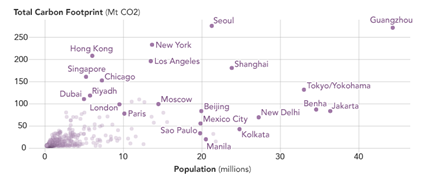Overview
Impacts of Urbanization
According to the UN, 55% of the world’s population currently live in urban areas, and that number is expected to increase to 68% by 2050. The bulk of this increase in urbanization is expected to come from only a handful of countries, with China, India and Nigeria projected to contribute nearly a billion people to the urban population 1. Despite advancing at unequal rates across the globe to date, urbanization is seeing an upward trend in its spread across developing regions.
Cities are resource-intensive, covering only 2% of the earth’s surface yet responsible for 75% of the world’s resource consumption and carbon emissions 1 2. The cost of inaction is therefore high, and so is the economic opportunity associated with decarbonization: researchers have found that emissions reduction in cities represents a USD$24 trillion opportunity. City-led efforts to mitigate and adapt to climate change by addressing their energy use have the potential to transform livability, equity, human health, and the urban experience.
Cities with the highest populations and wealth tend to have the largest carbon footprints. 10
Context
Cities as Consumers
Key drivers of consumption and carbon emissions within cities are electricity use, transportation and heating and cooling systems.
Case Study: Cooling Systems
Providing cooling for all is a challenge in a warming world. Cooling systems can be energy-intensive with air conditioning systems alone contributing half a billion metric tons of carbon dioxide per year 6 – and world consumption of energy for cooling systems is expected to increase tenfold by 2050 8.
In a 1984 study entitled “The End of the Long Hot Summer: The Air Conditioner and Southern Culture”, the author looks at the role of air conditioners in driving the growth of the urban American South by encouraging industrialisation,facilitating efficient use of space through high-rise development, and creating a comfortable environment in public institutions 7 (p. 621)
As multiple cities around the globe, especially in the Global South, are experiencing urbanisation and increasing living standards, the world can expect a surge in demand for air conditioning. This may cause emissions from air conditioning to outgrow the decline in emissions from heating reference number =8] 6, adding additional pressures to energy infrastructure.
The emissions from air conditioning can be mitigated by increased use of energy efficient cooling systems, and by ensuring that these systems are powered by clean, sustainable energy. Achieving this will rely on action from government and policy makers 9.
How Cities can Lead by Example
As mass consumers, and sometimes producers, of energy, cities wield sizable influence over the path of energy transitions. Change can often be implemented internally in cities and used as a model for outside expansion.
Since 1984, the city of Copenhagen has provided clean heating to 97% of its population by simply repurposing waste heat from electricity reproduction into heating for homes. The switch has resulted in 665,000 fewer tons of carbon dioxide emissions each year, saving the average family 1,400 euros on their heating bill annually 11.
Dive deeper
Recent blog posts about Cities: Urbanization and Rising Energy Demand
Student Energy at the UN Climate Action Summit
September 20, 2019
External resources
Cities and the SDGs
SDG 11 – SUSTAINABLE CITIES AND COMMUNITIES
Urban areas are specifically addressed under this goal, including the need for adequate housing, basic services, transportation systems, civic participation, public spaces, mitigation, adaptation, and disaster risk management to ensure “inclusive, safe, resilient, and sustainable” cities.Efficient urban planning and management practices must be in place to deal with the challenges brought by urbanization and the rising demand for energy.
One billion people still live without adequate housing or services in informal settlements or slums. The World Health Organization estimates that over 4.2 million deaths per year are attributable to ambient air pollution and that 90% of people living in urban areas breathed air that failed to meet its guidelines for particulate matter. The combustion of fossil fuels for transportation (especially diesel), traffic, and buildings are major sources of local outdoor (ambient) air pollution in many urban areas.
SDG 7 – AFFORDABLE AND CLEAN ENERGY
As we saw in the previous unit, energy access is a key pillar for human well-being, economic development, and poverty mitigation. While urban areas tend to have higher rates of energy access than rural areas, access is not equally distributed among the population–migrants, those living in informal settlements, women, and the poor often lack access at a higher rate. Read more about the human and environmental benefits of energy access.
The urban electricity access rate is 97% compared to 79% in rural areas, which still leaves 108 million urban residents without access. Many electricity connections in inner cities and informal settlements are considered “fragile.” This access can also be expensive; many low-income households in developing countries spend between 14-22% of their income on energy. Twenty-five percent of households in low-income cities lack access to clean cooking options.
SDG 12 – RESPONSIBLE CONSUMPTION AND PRODUCTION
This goal stands to address unsustainable production and consumption patterns that are using material resources inefficiently. As major population centres, cities are the sites of consumption and can account for embodied energy in goods and materials used.
